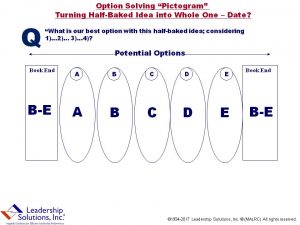by Peter A. Arthur-Smith, Leadership Solutions, Inc.®
“Genius is 1% inspiration and 99% perspiration,” Thomas Edison, serial inventor.
 |
Edison may well be right. Like Edison with his light bulb invention: Henry Ford built a major enterprise out of an inspirational idea – everyman’s automobile. Elon Musk is about to build major space and electric-auto businesses out of two inspirational ideas. Sergey Brin and Larry Page built a major social media company out of inspirational ideas with Google and its affiliates. Bill Gates and Paul Allen at Microsoft launched a major software house through some inspirational ideas. Sam Walton did the same at Wal-Mart – low prices.
In each case, they had to apply extraordinary perspiration to bring those ideas to fruition. Clearly they are all people with great imaginations. Coupled with that, they obviously made more good decisions than bad ones, although they would probably be the first to admit that they benefitted enormously from the latter: where the bad ones taught them a lot.
One of the things that likely helped them in their decision-making, was not being put-off by obstacles, or not taking “No” for an answer, or not being afraid to make mistakes. They came to learn that there were always other options, if only they could find them. Having that ability to park ideas at the back of their minds and let their imaginations run wild on them, until new options emerged, are other attributes that were at their disposal. Such attributes are abilities we all have, although some make use of them better than others. We can train ourselves or our people to do it; although it does take perspiration, which many of us are reluctant to splash-out on.
Coupled with this, they had to learn how to shrug-off snickers from friends, or ridicule from a boss or colleague, or parental scolding, or setbacks when trying to make their latest idea viable. They also had to learn how to scratch-around for resources, or assistance, or advice. Such activities require a lot of humility, which is why many inventors are rather humble, behind-the-scene types. Some turned their product fame into fortunes, which enabled them to develop a flamboyant veneer over their initial humility. That new found behavior is often termed by many as: (s)he’s eccentric.
And so, all the indications are that our imaginations are capable of being extremely valuable. However, we should accept that some people’s notions are more valuable than others, although, all too often, we go to tremendous lengths to shut them down. Maybe we don’t like it when others have better ideas than we do, so we tend to pooh-pooh them or shut them out; thereby enabling us to feel better about ourselves.
Within our organizations we’re inclined to put our people into mental straight-jackets, so they will remain on our designated path rather than release their imaginations. We rely on pages of policies and procedures to shut-off their ideas and keep them on a straight-and-narrow pathway and today’s business. Then we have the audacity to complain that our people aren’t creative enough…Is this our human wish to turn things on and off when it’s convenient for us?
What can we do to distance ourselves from this habitual bind? As executives or people leaders we need to think about the following imagination-releasing principles:
» Don’t encourage your people to leave their brains and ideas behind at home every day.
» Set aside time on a fairly frequent basis for your “thinkers” to brainstorm or release those ideas.
» Don’t fall into your time-short mindset because you’re overly focused on turning out widgets every day.
» Welcome odd-ball ideas because sometimes odd-ball ideas become brain-shattering ones.
» Give people due credit for their imaginative ideas and don’t try to take them on-board as your own…that shuts imaginations down quicker than anything.
Let’s suppose a person at your firm comes up with a half-baked business expansion idea, while your intuition tells to you that there may just be something there. Maybe you can develop it into a winning or whole-baked idea by using a decision making concept called option solving. Option solving is a means of stretching your number of possibilities around a half-baked idea, within the framework of an important question like: “What is our best option for expanding on idea XYZ …,” coupled with key considerations that expand or likely reduce your possibilities, such as, “…considering, 1) we have limited space, 2) we have ambitious staff, 3) our budgets are tight, and 4) the market seems ready for something else?” Keeping it to four considerations is probably a wise idea, so you don’t make your final deliberations too complex…see the adjacent “pictogram.” (NOTE: It is best for a “think-team” of 2-6 people from within your firm to put this question together.)

|
Now your “think-team” is in a position to establish ‘Yin and Yang’ bookends (B-E), which will not only prod their thinking but also realistically place reasonable boundaries around this team of imaginations. With these so-called bookends, you can now ask your chosen team to produce at least five alternative, realistic options (A-E) – outside that half-baked idea – to potentially produce a whole-baked idea. One of these options could well be the half-baked idea used as a bookend or option.
Once your “pictogram” of options is ready, encourage your think-team to set it aside for 20, 30, 60 minutes; or even a few hours. This allows for some objectivity created by emotional distancing.
When they return to it, their intuition, in combination with their rational mind, will be ready to make an optimal choice…not necessarily the perfect one. Once that choice is made, the team can go through another round of option solving – known as “Peeling the Onion” – as a means of adding weight or more meat onto the whole-baked decision-bone. You can follow-through with as many Peel-the-Onion rounds of sub-options as you wish to add more clarity to your decision and strategy.
Now that your think-team’s optimal option and sub-options are clear, it is well positioned to lay-out a gameplan; while the whole-baked idea is still fresh in their minds. Team members should then immerse themselves in Phase 2 – Enlightened Pathfinding.
Why don’t you get started with Phase I today and, since your organization is full of imaginative minds that need to be encouraged, consider setting-up “option-storming” sessions on a regular basis to turn half-baked ideas into whole-baked ones. Don’t become so obsessed with today’s business that you forget about tomorrow’s imaginative ideas, which could give your operation a bigger lift than it just keep plugging away at the same-old, same-old.
To learn more about decision-making, talk with:
